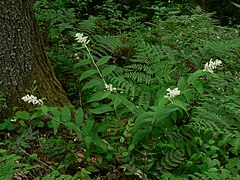Maianthemum
| Maianthemum subsp. var. | ||||||||||||||||||||||||||||||||||||||||||||||||||||||||
|---|---|---|---|---|---|---|---|---|---|---|---|---|---|---|---|---|---|---|---|---|---|---|---|---|---|---|---|---|---|---|---|---|---|---|---|---|---|---|---|---|---|---|---|---|---|---|---|---|---|---|---|---|---|---|---|---|

|
|
| ||||||||||||||||||||||||||||||||||||||||||||||||||||||
| ||||||||||||||||||||||||||||||||||||||||||||||||||||||||
Maianthemum (Latin Māia "May" and Greek ánthemon "flower"; including former Smilacina) is a genus of about 30 species of rhizomatous herbaceous plants in the family Ruscaceae, native to the understory of woodlands in North and Central America, northern Europe, northern and eastern Asia, and the Himalayas.
Flowers have six tepals, reduced to four in M. canadense, M. bifolium and M. dilatatum.
Because of genetic similarity, similar fruits, and evidence that the 4-tepal species evolved from a 6-tepal species, the genus Smilacina was combined with Maianthemum in the late 20th century.[1]
Both Maianthemum and Smilacina were formerly included in the family Liliaceae.
| Standard Cyclopedia of Horticulture |
|---|
|
Maianthemum (Greek, Mayflower). Syn. Uni- folium. Liliaceae. Small spring-blooming woodsy perennials, good for colonizing. Convallaria-like, with slender rootstocks and 1-3- Ivd. sts. that are 3-8 in. or more high and bear a few white 4-parted small fls. in a raceme; segms. separate or practically so, spreading or reflexed, deciduous; stamens 4, inserted at base of segms; ovary 1; style 1, 2-lobed: fr. a globular 2-celled and 1-2-seeded berry.— Species 2 (by some considered only 1), in the cool parts of northern hemisphere. They make interesting mats or colonies in shady places. M. canadense, Desf. (Unifolium canadense, Greene), native in moist cool woods from Newfoundland to N. C. and west, usually has 2 (1-3) ovate or ovate- lanceolate sessile or very short-petioled lvs. on the st. and many radical lvs. in the spreading colony, cordate at base with narrow sinus: raceme 1-2 in. long, usually many - fld., rather dense; fls. white, the segms. longer than the stamens: berry pale red, speckled: foliage dies in summer. M. bifolium, DC. (M. Convallaria, Web.) is the European and Asiatic species: lvs. 2, stalked, triangular-cordate: st. 6-8 in. high from a filiform root: raceme spike-like. Var. kamtschaticum, Jepson, Calif, to Alaska and Siberia, is 4-14 in. high, often stout: lvs. ovate or triangular-cordate, the petiole of the lower one sometimes longer than the blade, the radical If. very long-petioled and almost as tall as fl—st.
|
| Standard Cyclopedia of Horticulture |
|---|
|
syn. Smilacina (resembling smilax). Liliaceae. False Solomon's Seal. Perennial herbs, with simple stems from rootstocks, used for the hardy border or the wild-garden. Leaves alternate, nerved, and usually sessile: panicles or racemes terminal; fls. white or greenish white, sometimes fragrant; perianth 6-parted, spreading, withering-persistent; stamens 6; ovary 3-celled: berry globular, 1-2-seeded.—About 25 species, N. and Cent. Amer. and Temp. Asia. Vagnera is an older name for this genus and is used by some American writers; but on the principle of fifty years of established usage, Smilacina is retained in the "nomina conservanda" list of the Vienna Congress. Smilacinas are of easy culture in any good soil. They prefer a rich loam in a moist but not wet partly shaded place. They are handsome plants both in foliage and flower, particularly when growing with natural companions. S. racemosa is probably the most attractive. The plants may be forced slowly for bloom in the late winter and early spring. S. bifolia, Schult. f.- Maianthemum bifolium. CH
|
Cultivation
Propagation
Pests and diseases
Species
Species include:
|
|
Gallery
References
- ↑ "Maianthemum". Flora of North America.
- Standard Cyclopedia of Horticulture, by L. H. Bailey, MacMillan Co., 1963
External links
- w:Maianthemum. Some of the material on this page may be from Wikipedia, under the Creative Commons license.
- Maianthemum QR Code (Size 50, 100, 200, 500)
